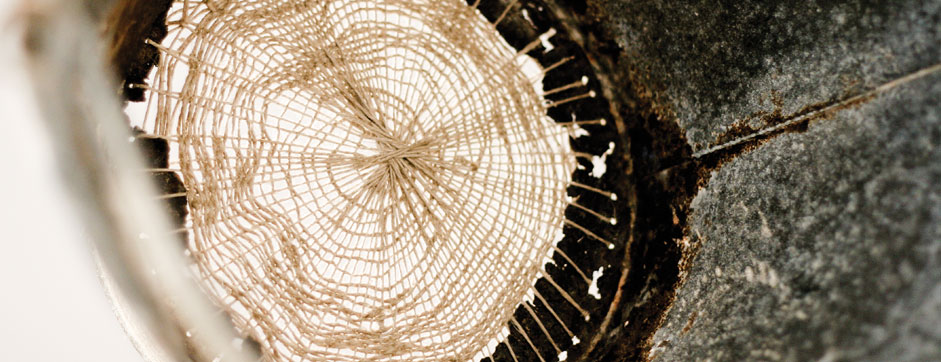2nd September 2010
‘…this is a credibly fresh attempt to read a series of deeply felt historical events and circumstances from a new perspective with new materials. It succeeds both as art and as a form of social cohesion.’
Full review by Giles Sutherland:
Close-Knit, Timespan, Helmsdale, Sutherland.
Perhaps it’s the zeitgeist but knitting certainly seems to be de rigueur at the moment. Recently, Dunbar Arts Trust staged a recreation of the town’s harbour using knitted fabric (and were ‘tweeted’ on Radio Four’s ‘Women’s Hour’). Currently, there’s also a knitting conference1 being held in Shetland to celebrate the craft’s fascinating and long history.
At Timespan, as part of its ‘bridging’ project where artists work in conjunction with the local community, East Lothian artist Julia Douglas, as part of a recent residency, has chosen to focus on the ancient and valued craft of knitting as a means of collaborative interaction with the town’s residents. It’s a brilliant and insightful move because knitting accesses a wealth of traditions, customs and techniques and embraces social and economic history, as well as a domestic one. Knitting also bridges the gender gap because although most of the woollen garments were made by woman they were worn by both sexes equally. For example, each fishing community on the Moray Firth devised its own knitted pattern pullover so that drowned fishermen could be readily identified.
Julia Douglas has succeeded in bringing together a number of community elements and elevating knitting from a craft to an artistic medium without loosing sight of its traditions and values.
A flavour of Douglas’ approach is given in what, at first glance, appears to be a bona fide estate agent’s sales brochure entitled ‘Foxglove Cottage: A superb compact bijou residential croft in the heart of Caithness’. However, this is quickly revealed as a satirical document which skilfully employs the estate agent’s notoriously euphemistic jargon to give an account of the material living conditions of the Caithness crofters in the 19th century:
The property currently lacks plumbing and electricity; however, a stream passes near the croft, supplying a clean water source; peat banks are less than five minutes’ walk, providing an ideal source for winter fuel, and an abundant source of mutton fat and fish oil is obtainable for candle making and lamp oil. The opportunity to build a dry outhouse is offered for sewage disposal and a chamber pot may be used overnight…. N.B. Though children may be encouraged to help with all crofting activities, small children and animals must be tethered to a stone or stake at all times when out doors, as the cliff edge is close!
The document – written and conceived by Douglas and Lorna Jappy – is based on historical fact; the last sentence refers to the practice of Badbea crofters (Badbea is a Clearance village several miles north of Helmsdale on the Caithness coast) of tethering small children to prevent them from falling from a nearby coastal cliff.
This, in turn, is the basis of another collaborative work ‘For Your Own Good’ made with local primary children and the Helmsdale knitting group.2 The installation consists of 21 woollen bootees (representing the number of children under 10 years in Badbea at the time of the 1841 census) and three large woollen boulders to which the bootees are ‘tethered’. The exhibition notes go so far as to ascribe individual children’s names and ages to each item of footwear. As well as being a fun piece it also has a serious intent, illustrating the precariousness of these crofters’ lives and the danger and difficulty they faced on a daily basis. But most importantly it clearly illustrates the resident artist’s role as an ‘ideas catalyst’ involving others in a type of narrative art-making from which they might otherwise be excluded.
Another of Douglas’ individual works, ‘One Perfectly Good Bucket’ references the traditions of arte povera and ‘installation’ art but gives it a particular local resonance. Douglas found the damaged bucket on one of the ruined crofts in Wester Helmsdale and repaired it with string – referring to the traditional crofter’s habits of frugality and resourcefulness. Thus the object is transformed from uselessness to utility, and from the discarded to the valued.
Despite the now overworked theme of the Highland Clearances, and the concomitant devices it relies on – ruined crofts, a dispossessed and disenfranchised people, hardship and suffering – this is a credibly fresh attempt to read a series of deeply felt historical events and circumstances from a new perspective with new materials. It succeeds both as art and as a form of social cohesion.
Written by Giles Sutherland, who writes Art criticism in Scotland and internationally.
